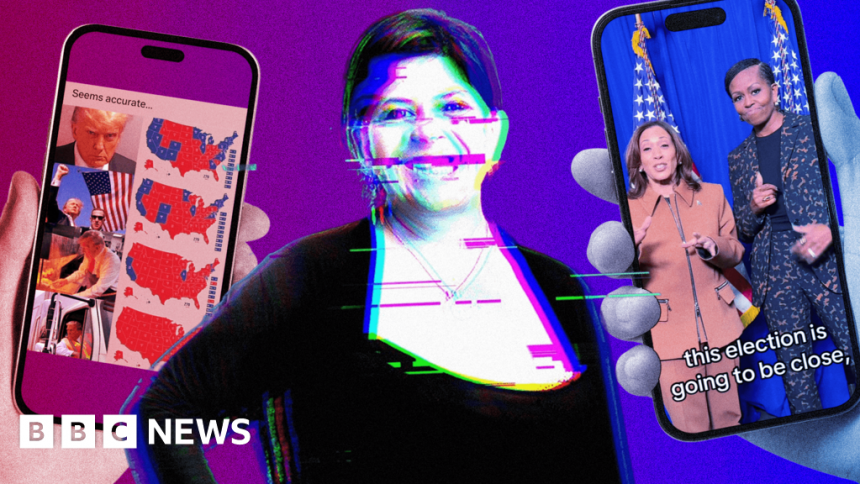Gabriela is an undecided voter. Here’s the very different content TikTok and X showed her
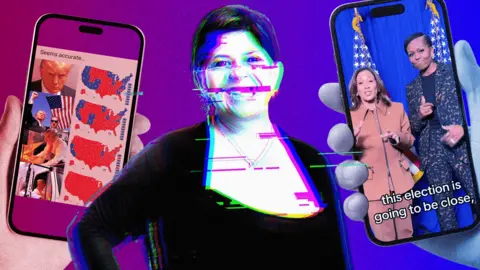 BBC
BBCMeet Gabriela. She’s in her forties, Latina, and lives in Miami. She’s not that into politics, but she does care about the economy – and abortion rights. And she doesn’t know if she’ll vote – or who for. The only catch? She’s not real.
Gabriela’s one of five fictional characters I created in 2022 to monitor how different people, with different political views, are targeted by content on social media. She’s been part of an ongoing experiment for the BBC’s Americast podcast, investigating how social media algorithms may be influencing people’s vote.
With election day fast approaching, it’s the undecided and disillusioned voters who the two main presidential candidates are making last ditch attempts to win over. How is the battle unfolding over their different social media feeds?
While some of these “undercover voters”, as we call them, were created to represent a certain political point of view based on data from the Pew Research Centre, Gabriela began by essentially expressing no interest in politics at all on her social media feeds. But over the past two years her feeds have morphed as I’ve watched and followed the content she’s recommended.
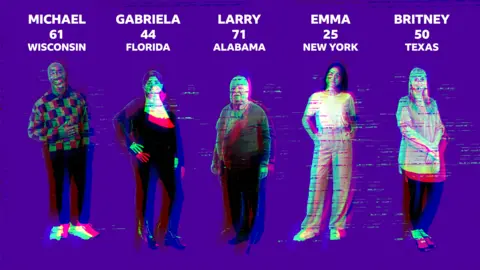
How do you create an undercover voter? First, I made her profiles across the major social media sites – X, TikTok, Instagram, Facebook and YouTube. I kept her account private, and, since she wasn’t political, had her follow and engage with content that had nothing to do with politics – coupon pages, dance videos, community groups and other Spanish-language content.
All five characters have private accounts, and no friends.
These social media profiles can’t offer an exhaustive view into what every voter is being pushed online, but they can offer an insight into the impact of social media sites this election.
Whenever she was recommended content on any of the platforms, I engaged with it – whether it was watching the latest TikTok dance or following a Facebook page about saving at the supermarket – to see what the algorithms would recommend to Gabriela next.
Soon, she was being recommended political content, too.
Now there’s a war raging inside her feeds between Donald Trump and Kamala Harris – and who appears to have the upper hand is different depending on which social media site she looks at.

Conspiracy theories and garbage trucks on X
Gabriela’s feed on X is dominated by stand-out moments from Donald Trump’s presidential campaign, mainly from profiles that have purchased blue ticks on the site.
One popular meme, for example, featured four images from Trump’s campaign, from his mugshot to his recent photo-op riding in a garbage truck. Alongside the photos are maps of the US showing states switching to red for the Republicans.
“Seems accurate” reads the cation. The message was clear: Trump is making a comeback.
Content created and shared by Trump’s very active supporters on X rack up tens of millions of views. While there are also groups of accounts supporting Harris, they didn’t make it to Gabriela’s feed as often. Posts about Trump also tended to focus on him as a person – when policy was mentioned, it was usually about immigration or the economy.
A major change occurred at X after I set up Gabriela’s profile in August 2022: Elon Musk bought the social media company. Since his takeover of Twitter in October 2022, Mr Musk has made a number of changes – from renaming it X to offering a paid-for premium service.
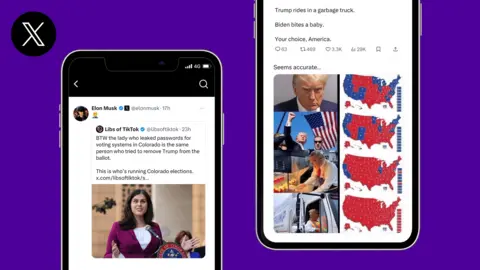
There have also been changes to the algorithm, affecting what kinds of content gets the most traction.
Now, almost every time I open Gabriela’s feed on X, I see a post from Mr Musk himself close to the top. He repeatedly posts in support of Trump, and in recent days he’s re-shared some unfounded claims of election fraud. This is very different from what her feed looked like when she first created her account.
One recent post Mr Musk re-shared, which her profile was recommended, spread unfounded rumours about election officials in Colorado being possibly complicit in voter fraud.
The post Mr Musk re-shared referred to an employee error exposing passwords for some election equipment.
According to officials in the state, though, the “vote counting equipment requires two passwords to access, and those passwords are kept separately” which they say means “election system remains completely secure” following the error.
I spent time this summer with election officials in a centre where the votes are counted in Jefferson county, Colorado.
One IT worker called Cuong told me how since 2020, he and his colleagues have been repeatedly “targeted with harassment, accusations of us doing nefarious things”, triggered by unfounded allegations of – for example – hacked or broken voting machines.
Fan montages and Puerto Rico on TikTok
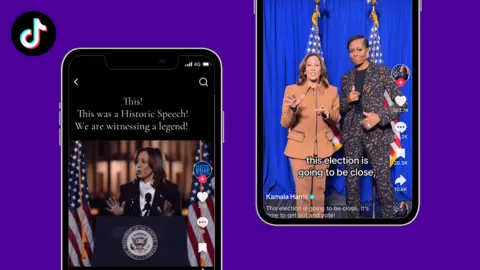

Gabriela’s feed on TikTok, on the other hand, is frequently recommended montages of Kamala Harris, often speaking at rallies. These are created by supporters and similar to the kinds of posts users create to support their favourite celebrity or musician.
One reads “America is ready for Kamala Harris” from an account called Latinos for Harris.
The clips tend to focus on Harris as a person, rather than her policies – although several do reference the topic of abortion rights and the issue of personal freedom.
When a comedian at Donald Trump’s Madison Square Garden rally called Puerto Rico “a floating island of garbage”, it sparked backlash from many in the Latino community.
Gabriela’s TikTok feed has featured some video clips of that moment, or commentary on that moment, frequently with Spanish captions taking offence to those comments.
The algorithm pushed content highly relevant to Gabriela’s identity as a Latina voter.
There’s some content from the official accounts belonging to both Donald Trump and Kamala Harris’s campaigns on her feed too.
One campaign video shows Harris alongside Michelle Obama in front of an American flag declaring this election is “going to be close”, with 7.7 millions views.
Another shows Donald Trump dancing alongside popular streamer Adin Ross. That has 67.1 million views – showing how his content is having a huge reach, even if not so much on Gabriela’s feed.
YouTube, Instagram and Facebook
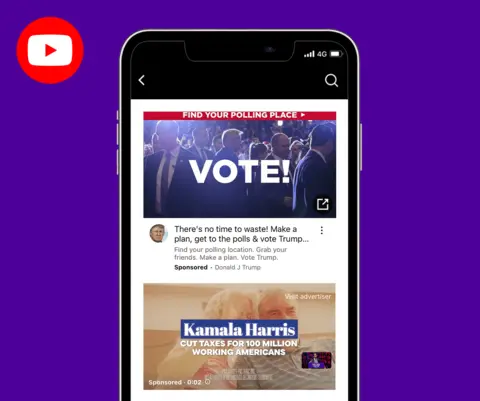
While TikTok prohibits political ads, it’s not the same on YouTube, where Gabriela has been targeted by several about both of the main candidates. The paid-for ads she receives tend to focus on the economy. A video from Harris’s campaign team saying she will “cut taxes for 100 million working Americans”. Another advert from Trump’s team declares “there’s no time to waste! Make a plan, get to the polls & vote Trump”.
A lot of this content, whether ads or posts from the campaigns and supporters, seems focused on motivating people to actually go out and vote, rather than change their minds about a topic.
Like her TikTok feed, Gabriela’s YouTube leans towards partisan political content, opinions and campaign messages. But I’ve not seen the same kinds of posts pushing unsupported claims of voter fraud that I’ve spotted on Gabriela’s X feed. Her X feed has been overtaken by almost entirely political posts.
Her Instagram and Facebook accounts have remained fairly apolitical. Meta, which owns both of the social media companies, decided to stop recommending political content from accounts that users don’t already follow earlier this year.

- SIMPLE GUIDE: All you need to know about the vote
- EXPLAINER: What Harris or Trump would do in power
- GLOBAL: Vote weighs on minds of Ukraine’s frontline soldiers
- PATH TO 270: The states they need to win – and why
- IN PICS: Different lives of Harris and Trump
- POLLS: Who is winning the race for the White House?
What does this tell us?
The biggest changes I’ve spotted on Gabriela’s social media feeds over the two years I’ve been running her profile have happened on X.
In recent weeks, Mr Musk has been very vocal about his support for Trump, which he’s entitled to do as a private citizen. He has also accused Twitter of old – as well as other social media sites – of suppressing right-wing view points. And he has previously said he believes X is a space for all political opinions.
But Gabriela’s feed shows how, at least to one originally neutral viewer, the site skewered in Trump’s favour – which appears to be in part because of changes to how the site works under Mr Musk’s tenure.
Last month, X also changed its rules so accounts can make money according to engagement from premium accounts – likes, shares and comments – rather than the ads that pop up under their posts.
I investigated how these changes helped some users make thousands of dollars, they say, from sharing content that included election misinformation, AI-generated images and unfounded conspiracy theories.
X’s user base is smaller than lots of other sites. But it is the home of politicians, activists and journalists and screengrabs from its site can migrate onto larger platforms.
Another significant but less extreme shift has occurred on Gabriela’s TikTok feed.
Before she didn’t see much about the Democrats, but after Joe Biden announced he was no longer running to be President her feed has been increasingly flooded with pro-Kamala Harris videos.
Because Gabriela isn’t real, it’s impossible to know how much she would react to any of these social media posts. Plenty of factors beyond the online world could shape her decision.
One thing’s for sure, though, my previously apolitical voter has not been able to avoid the deluge of politics – and algorithms on the sites, which appear to favour engagement over all else, are shaping the way that she receives politics through her feeds. Who and how she votes could depend on which social media site she trusts and relies on.
X did not respond to questions from the BBC. X says online that its priority is to protect and defend the user’s voice. All of the other major social media companies say they have policies and measures in place to protect users from disinformation and hate.



